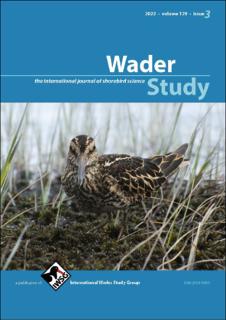| dc.contributor.author | Sandercock, Brett | |
| dc.contributor.author | Rae, Robert | |
| dc.contributor.author | Rae, Stuart | |
| dc.contributor.author | Whitfield, D. Philip | |
| dc.coverage.spatial | Northern Norway, Finnmark, Kautokeino | en_US |
| dc.date.accessioned | 2023-01-10T13:09:29Z | |
| dc.date.available | 2023-01-10T13:09:29Z | |
| dc.date.created | 2023-01-09T12:01:25Z | |
| dc.date.issued | 2022 | |
| dc.identifier.issn | 2058-8410 | |
| dc.identifier.uri | https://hdl.handle.net/11250/3042365 | |
| dc.description.abstract | The Broad-billed Sandpiper Calidris falcinellus is an elusive and seldom studied species of wader that breeds in wet fen habitats in the Palearctic taiga. In a 25-year population study from 1995–2019 near Kautokeino, Norway, we investigated the use of biometrics for sexing, tested for patterns of sexual size dimorphism, compared seasonal variation in biometrics, and calculated the first estimates of annual survival for the species. Most birds could be sexed using bill length: ≤29.9 mm = male, 30.0–31.5 mm = either sex, and ≥31.6 mm = female. Sexual size dimorphism was female biased with the greatest dimorphism in bill length (F/M = 1.12), with disassortative pairing for bill length between birds in mated pairs. Body mass and wing length of Broad-billed Sandpipers varied among different stages of the annual cycle and in a pattern consistent with the energetic demands of migration and timing of feather moult. Annual survival was estimated with Cormack-Jolly-Seber models based on time-since-marking to control for losses after first capture and imperfect detection, and to test for sex and age effects. Apparent survival was 0.736 ± 0.060 SE among previously marked birds that returned at least once to the study area, with an mean life expectancy of 5.3 ± 0.9 SE years and a new longevity record of 13+ years. Apparent survival was within the range of expected values based on published estimates for other small-bodied sandpipers. Population declines of –5.4% per year have been reported in Fennoscandia, and a better understanding of the factors affecting demographic performance during the migratory and overwintering stages of the annual cycle will aid future conservation of the Broad-billed Sandpiper. apparent survival biometrics Calidris falcinellus Finnmark life expectancy mark-recapture | en_US |
| dc.language.iso | eng | en_US |
| dc.rights | Attribution-NonCommercial-NoDerivatives 4.0 Internasjonal | * |
| dc.rights.uri | http://creativecommons.org/licenses/by-nc-nd/4.0/deed.no | * |
| dc.subject | apparent survival | en_US |
| dc.subject | biometrics | en_US |
| dc.subject | Calidris falcinellus | en_US |
| dc.subject | Finnmark | en_US |
| dc.subject | life expectancy | en_US |
| dc.subject | mark-recapture | en_US |
| dc.title | Sexual size dimorphism, disassortative pairing, and annual survival of Broad-billed Sandpipers in northern Norway | en_US |
| dc.title.alternative | Sexual size dimorphism, disassortative pairing, and annual survival of Broad-billed Sandpipers in northern Norway | en_US |
| dc.type | Peer reviewed | en_US |
| dc.type | Journal article | en_US |
| dc.description.version | publishedVersion | en_US |
| dc.rights.holder | © 2022 The Authors | en_US |
| dc.subject.nsi | VDP::Zoologiske og botaniske fag: 480 | en_US |
| dc.subject.nsi | VDP::Zoology and botany: 480 | en_US |
| dc.source.volume | 129 | en_US |
| dc.source.journal | Wader Study | en_US |
| dc.source.issue | 3 | en_US |
| dc.identifier.doi | 10.18194/ws.00288 | |
| dc.identifier.cristin | 2103173 | |
| dc.relation.project | Norges forskningsråd: 160022 | en_US |
| cristin.ispublished | true | |
| cristin.fulltext | original | |
| cristin.qualitycode | 1 | |

